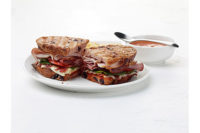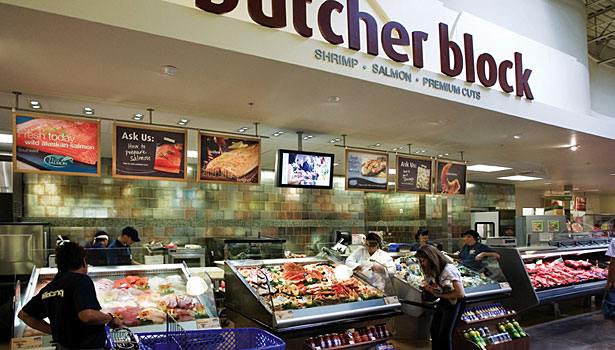2013 Deli Report
The growth and popularity of the prepared-foods section of the deli shows no signs of slowing down.










The supermarket deli provides consumers with an appealing alternative to walking up and down aisles of packaged food products, gathering enough ingredients to mix together and combine into a meal that, with any luck, tastes good. The deli and its increasingly important prepared-foods section lets them walk up to one counter, order everything they need for a meal and leave. Instead of spending hours in preparation and cooking, shoppers could be eating their meal in a matter of minutes.
The Hartman Group reported in its 2012 paper, The Third Grocery Sector, that over the past decade, deli/prepared foods sales have outpaced the growth of packaged foods (including frozen) and the oldest segment of packaged meals, the shelf-stable meal categories such as dinner mixes, canned soup and canned vegetables.
The International Dairy-Deli-Bakery Association (IDDBA) will release this fall its annual What’s in Store trends report, which provides data on past and future projections on growth, trends and category changes. The 2014 edition is available for purchase at the IDDBA’s Web site, www.iddba.org.
This year’s report referenced IDDBA’s own research paper, Filling the Gap, which found that of the 61.4% of shoppers who visited the sliced meat and cheese areas on their last trip to the store, roughly two-thirds made a purchase. More than 41.8% of customers that shop traditional supermarket delis made a meat or cheese purchase; 35.8% did the same from specialty supermarkets such as Whole Foods and Trader Joe’s. The NPD Group’s DeliTrack reported 17% of adults made at least one weekly deli meat purchase in the 52 weeks ending March 2013.
“According to data from Nielsen Perishables Group Fresh-Facts Shopper Insights powered by Spire, deli meat household penetration was 62.7%, a decrease of 1.16% from a year ago,” the association reported. “In the 52 weeks ending April 27, 2013, deli beef dollar and volume growth stalled, at least temporarily, as increased production costs hit the retail price tag for consumers. Chicken and bacon, on the other hand, have seen increased growth.”
Among the trends that the IDDBA reported for deli meats in What’s in Store 2014,
-
Prepackaged deli meat sales increasing: The deli packaged meat category grew approximately 6.5 percent in 2011 over the previous year. Consumers appear to be moving back toward name-brand packaged refrigerated meats. Hard-to-refuse offers from major deli meat manufacturers helped persuade customers to make the switch. Half of shoppers prefer to purchase name-brand turkey according to Technomic, while 45% choose branded chicken.
-
Premium and specialty deli meats in demand: Specialty meats like Prosciutto, Pancetta, Mortadella and Asada beef are increasingly present on menus, food TV shows, and Web sites. Artisanal products have become a specialty for deli and cheese departments as well from fine charcuterie to Hispanic-favored headcheese.
-
The “natural” state: IDDBA’s Filling the Gap study identified an opportunity to grow sales around lunchmeat featuring the “all natural” label. A TURF (Total Unduplicated Reach and Frequency) analysis, used to find the optimal combination of items for a given level of resources to gain the highest total appeal, showed an increase in deli meat purchasing frequency of flavor-added products that also carried the all-natural label. Consumers are becoming more suspicious of the “natural” label and are looking more closely at the ingredients and nutrition panel to make their own decision. On the other hand, in the 52 weeks ending Feb. 23, 2013, dollar sales of deli meat items with healthy claims like lower sodium, low fat, and gluten-free grew 3% compared to 1% for traditional alternatives, according to Nielsen Perishables Group.
Being prepared pays off
Perhaps no other sector of the deli department has taken off in recent years as prepared foods has.
“Long before the recession, savvy consumers were already figuring out that the best prepared-foods departments in their local area offered a better value than take-out restaurant food,” the Hartman Group reported. “Upscale grocers like Whole Foods and Trader Joe’s were especially good at developing loyalty around this one department. Whole Foods did it by selling fresh, unpackaged take-out. Trader Joe’s did it by packaging and branding restaurant-quality refrigerated meals.”
The Hartman Group in its report noted that while it is not a major profit pool for grocers yet, deli/prepared foods is exhibiting strong demand, suggestive of an unconscious demand for fresher-tasting, convenient meal options in the traditional grocery store.
David Rodriguez, brand manager for Butterball, notes that the prepared-foods category in deli is up in every segment, from rotisserie chicken to pizzas to entrees. One of the interesting aspects of that growth, he adds, is that it has come from stealing sales away from quick-service restaurants. He points out that consumers are looking for easier ways to feed their families or themselves, and the perception is that fast food is not healthy.
“Retailers in their delis are being very smart in offering prepared foods that are better for you, and it’s as easy as going to McDonald’s and ordering a hamburger,” Rodriguez says. “You can go to a Harris Teeter and get something that is better for you and is simple to get.”
Rodriguez adds that while Butterball does not have any products in the prepared-foods arena, that is expected to change.
“We have an initiative that we are working on fast and furiously that is going to be coming in the near term,” he says.
More of everything
One area where Butterball has excelled is providing a variety of deli meat options. Rodriguez notes that the trend to offer more flavors and more health options is being seen in all aspects of the supermarket.
“Unique and bolder flavors have been driving growth in the deli meat category,” he says, adding that the company’s plan to participate in that growth led to products that featured not only bold flavors but good taste as well.
The company’s Artisan Seasoned line was launched in 2012 and expanded this year. Some of the flavors in the line include Smoky Chipotle, Herb Roasted, Jamaican Jerk and Italian Seasoned. While the flavors may be bold, they are made to enhance the taste of the turkey and not overpower it.
Rodriguez says that the influx of people into the United States from around the world has led to an increased interest in fusion cuisine and Hispanic-influenced foods. These new consumers, as well as shoppers who are interested in trendy flavors, open up a market to a Smoky Chipotle turkey breast that may not have existed several years ago.
“We have people with different tastes and different perspectives as far as food, and that’s changing the game,” he explains.
The to-do list
The task for retailers and their meat suppliers is to keep customers returning to the deli department again and again. Fortunately for supermarkets, a majority of consumers continue to see value in the deli department.
More than two-thirds (67.9%) of consumers polled in the 2013 National Grocers Association/Supermarket Guru Consumer Panel Survey named the fresh food deli as “very important” or “somewhat important,” notes the IDDBA’s What’s in Store report. That percentage had been in decline for the last two years but increased in this year’s report.
“It may take innovations in foods and speedier service to restore deli’s luster against other convenient fresh and prepared-food options,” the report noted. Technomic notes that one way for delis to accomplish that might be to consider heeding consumers’ desires for more healthy options, ethnic options, and more variety.
Rodriguez says meat suppliers also need to step up and provide leadership to their retail customers. As consumers increasingly demand more variety, delis need their deli suppliers to bring their areas of expertise to the table and keep their shoppers happy.
“Our customers look for us to come up with products that are turkey-based and unique or different, because at the end of the day what [consumers] are looking for is assortment,” he says.
One recommendation to retailers and processors from The Hartman Group is to be aware of the increasingly strong connections consumers are making between animal-welfare issues and the beef, poultry and related proteins in both the deli departments and the meat case. A recent study (Sustainability 2013: When Personal Aspiration and Behavior Diverge) found that an increase in the media coverage around industrial farming practices has raised consumer awareness of issues relating to animal welfare.
Consumers show a tendency to connect animal welfare to product quality, believing that companies that look after their animals are also likely to look after their products. Not only do consumers feel good about purchasing meat from animals that have lived a “good life,” they believe that those meat products are of better quality and more nourishing.
“We believe those beliefs will become increasingly important in the years ahead, fed both by media coverage of industrial farming and the consumer pursuit of higher quality experiences,” The Hartman Group says.
Looking for a reprint of this article?
From high-res PDFs to custom plaques, order your copy today!











